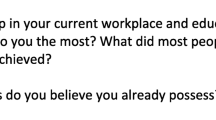Abstract
In this article, I address how teachers in urban and suburban U.S. schools with multicultural and multilingual student populations demonstrate leadership both within their classrooms and schools as well as outside of them. Based on research with U.S. public school teachers in two projects (Nieto What keeps teachers going? New York: Teachers College Press 2003, Why we teach. New York: Teachers College Press 2005), various roles that teachers have in initiating, putting into practice, and sustaining change in schools are described. Implications for policymakers and administrators are then briefly explored.
Similar content being viewed by others
References
Anyon, J. (2005). Radical possibilities: Public policy, urban education, and a new social movement. New York: Routledge.
Bode, P. (2005). Waiting tables and juggling motherhood: Taking the road less traveled. In S. Nieto (Ed.), Why we teach (pp. 49–57). New York: Teachers College Press.
Flores-González, N. (2002). School kids, street kids: Identity and high school completion among Latinos. New York: Teachers College Press.
Foucault, M. (1980). Truth and power. In C. Gordon (Ed.), Power/knowledge: Selected interviews and other writings 1972–1977 (pp. 107–133). Brighton, UK: Harvester Press.
Freire, P. (1970). Pedagogy of the oppressed. New York: Seabury Press.
Gavins, A. (2005). Being on a moving train. In S. Nieto (Ed.), Why we teach (pp. 97–104). New York: Teachers College Press.
Giroux, H. A. (1988). Teachers as intellectuals: Toward a critical pedagogy of learning. Granby, MA: Bergin & Garvey.
Gordon, S. (2005). Teaching to affirm In S. Nieto (Ed.), Why we teach (pp. 71–80). New York: Teachers College Press.
Gould, S. J. (1981). The mismeasure of man. New York: Norton.
Harry, B., & Klingner, J. (2006). Why are so many minority students in special education? Understanding race and disability in schools. New York: Teachers College Press.
Jenoure, T. (2000). Navigators: African American musicians, dancers, and visual artists in academe. Albany: State University of New York Press.
Jenoure, S. (2005). Looking back in wonder In S. Nieto (Ed.), Why we teach (pp. 61–70). New York: Teachers College Press.
Lima, A. (2005). Teaching as a spiritual journey In S. Nieto (Ed.), Why we teach (pp. 87–96). New York: Teachers College Press.
Marquez, Y. D. (2005). Opening their eyes to a new and bigger world In S. Nieto (Ed.), Why we teach (pp. 134–141). New York: Teachers College Press.
National Center for Education Statistics (2005). 1999–2000 Schools and staffing survey (SASS) and 2000–2001 Teacher follow-up survey (TFS) CD-Rom: Public-use data with electronic codebook. Washington, DC: Author.
National Collaborative on Diversity in the Teaching Force (2004). Assessment of diversity in America’s teaching force: A call to action. Washington, DC: Author.
National Commission on Teaching, America’s Future (1996). What matters most: Teaching for America’s future. New York: Author.
Nichols, S. L., & Berliner, D. C. (2007). Collateral damage: How high-states testing corrupts America’s schools. Cambridge, MA: Harvard Education Publishing Group.
Nieto, S. (2003). What keeps teachers going? New York: Teachers College Press.
Nieto S. (Ed.) (2005). Why we teach. New York: Teachers College Press.
Nieto, S., & Bode, P. (2008). Affirming diversity: The sociopolitical context of multicultural education (5th ed.). Boston: Allyn & Bacon.
Oakes, J. (2005). Keeping track: How schools structure inequality (2nd ed.). New Haven, CT: Yale University Press.
Orfield, G., & Lee, C. (2005). Racial transformation and the changing nature of segregation. Cambridge, MA: The Civil Rights Project at Harvard University.
Olsen, L. (2006, January 5). A decade of effort: Quality counts marks its 10th year in print with a comprehensive review of the nation's movement toward higher academic standards and greater accountability. Education Week. Retrieved July 27, 2007 from http://www.edweek.org/ew/articles/2006/01/05/17overview.h25.html
Pellerin-Duck, M. (2005). The colors and strands of teaching In S. Nieto (Ed.), Why we teach (pp. 127–133). New York: Teachers College Press.
Peterson, S. (2005). Always another beginning In S. Nieto (Ed.), Why we teach (pp. 156–165). New York: Teachers College Press.
Rethinking Schools (2007). Rethinking our classrooms (2nd ed., Vol. 1). Milwaukee, WI: Author.
Rothstein, R. (2004). Class and schools: Using social, economic, and educational reform to close the Black-White achievement gap. New York: Teachers College Press, and Washington, DC: Economic Policy Institute.
Sanders, W. L., & Rivers, J. C. (1996). Cumulative and residual effects of teachers on future student academic achievement. Knoxville, TN: University of Tennessee Value-Added Research and Assessment Center.
Tatum, B. D. (1997). Why are all the Black kids sitting together in the cafeteria? and other conversations about race. New York: HarperCollins.
U.S. Census Bureau (2004). Ability to speak English by languages spoken at home for the population 5 years and over: 2000. Washington, DC: Author.
U.S. Census Bureau (2000a). Profile of selected social characteristics, 2000. Washington, DC: U.S. Department of Commerce.
U.S. Census Bureau (2000b). Statistical abstract of the United States: 2000. Based on Population Estimates Program and Population Projections Program. Washington, DC: U.S. Department of Commerce.
Valenzuela, A. (1999). Subtractive schooling: U.S.-Mexican youth and the politics of caring. Albany: State University of New York Press.
Welborn, J. (2005). The accidental teacher In S. Nieto (Ed.), Why we teach (pp. 15–22). New York: Teachers College Press.
Author information
Authors and Affiliations
Corresponding author
Additional information
Article based on keynote address given at the Third International Summit for Leadership in Education, Boston, MA, November 2006.
Rights and permissions
About this article
Cite this article
Nieto, S. The color of innovative and sustainable leadership: Learning from teacher leaders. J Educ Change 8, 299–309 (2007). https://doi.org/10.1007/s10833-007-9044-8
Received:
Accepted:
Published:
Issue Date:
DOI: https://doi.org/10.1007/s10833-007-9044-8




